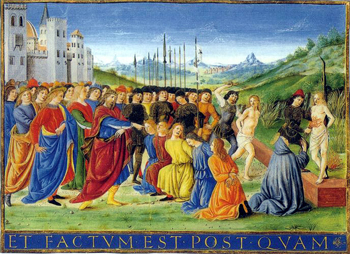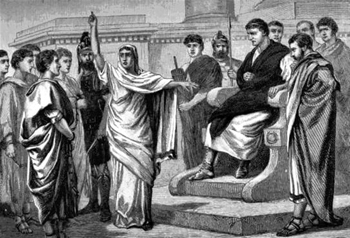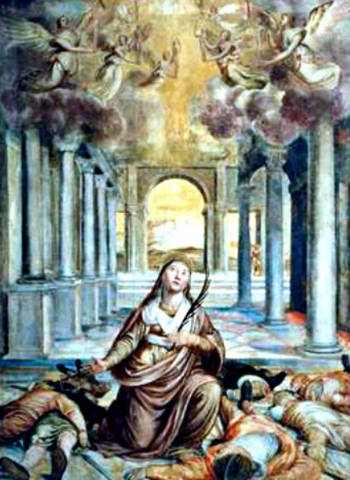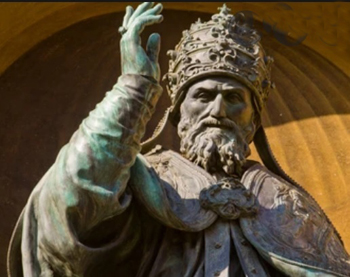Saints of the Day
 |
 |
 |
 |
 |
 |
 |
The Seven Sons of St. Felicitas, Martyrs
July 10
Note: On July 10, the Church commemorates the feast day of the Seven Sons of St. Felicitas, or St. Felicity of Rome, and her feast day on November 23. TIA will post the same text for both dates.
Biographical selection by St. Gregory the Great:
Homily on Blessed Felicitas: Consider, dear brothers, this man's heart in a woman's body. Before death she stood without fear. She feared to lose the light of the truth in her sons if she kept them alive.
 Shall I call this woman a martyr? She is more than a martyr, since she died seven times before her own death, by each of the seven wages of love which she sent to precede her in the Kingdom. The mother saw the death of her sons with great suffering, but without fear. She mixed the joy of hope with the pain of nature. She feared for them to live, she rejoices at their death. She wished to leave none after her, lest, in order to preserve one of them as a survivor, she could not keep him as a companion in Heaven.
Shall I call this woman a martyr? She is more than a martyr, since she died seven times before her own death, by each of the seven wages of love which she sent to precede her in the Kingdom. The mother saw the death of her sons with great suffering, but without fear. She mixed the joy of hope with the pain of nature. She feared for them to live, she rejoices at their death. She wished to leave none after her, lest, in order to preserve one of them as a survivor, she could not keep him as a companion in Heaven.
Let none of you imagine, dear brothers, that seeing her sons die, the heart of this mother did not vibrate with natural tenderness. Her sons, whom she knew to be her own flesh, she could not but see them die with pain, but she had within her a strong enough love to overcome the pain of flesh. Felicitas loved her sons as nature intended, but for the sake of the heavenly fatherland, she wished that those whom she loved should die, and even in her presence. It was she who felt their wounds, but it was she who multiplied herself, so to speak, in the person of the sons who preceded her to the Kingdom.
With reason I call this woman more than a martyr, for in her ardor she died in each one of her sons, and thus reaching a many-fold martyrdom, she carried away a palm that exceeds that of the martyrs.
The ancients had the custom that the consul would hold office for a fixed period of time. But if one of them became consul for the second or third time, he surpassed in praise and dignity those who had had the position only once. Therefore, Blessed Felicitas surpassed the martyrs in their glory for she died as many times as the sons she had, who died for Christ before her. Her love for God was such that her own death was far from sufficient.
Comments of Dr. Plinio:
Here you have a text of great elevation written by a Father and Doctor of the Church, Pope St. Gregory the Great (590 to 604).
He says that facing the possibility of having her sons die, St. Felicitas feared more for the loss of their faith than for the loss of their lives.
 He calls her more than a martyr because each time one of her sons would go before the tyrant, the prefect Publius, she would die with him. She contemplated their deaths without terror, standing without fear.
He calls her more than a martyr because each time one of her sons would go before the tyrant, the prefect Publius, she would die with him. She contemplated their deaths without terror, standing without fear.
She suffered the natural pain of seeing her sons being killed one by one before her eyes, but St. Gregory says, she overcame that pain of nature with the valor of Christian hope. That is, she had the certainty that her sons would die and go to Heaven. This is how she conquered her natural pain.
He says that she feared that they would live and rejoiced at their death. It is a beautiful thought, because if they were to live they would live as apostates; thus she feared that they would live, and she rejoiced at their deaths because they died as martyrs and won Heaven.
She knew she would be killed soon after her sons, so she thought: "I desire that none of them survives because all will be my companions in Heaven." The opposite is also true: "If my sons were to remain on earth it is because they apostatized. I do not want this."
Then, St. Gregory addresses his audience and explains that she had a natural maternal instinct. There is a great deal of Catholic balance in this position. It raises our admiration to see a mother who, placing all her hope in Heaven, watches all her sons die before her eyes. But, on the other hand, she does not lose her maternal instinct that causes suffering; otherwise her action would horrify us.
 St. Gregory knows how to show this masterpiece of equilibrium that is Catholic sanctity: On the one hand the heart beats painfully because the mother sees her son die; on the other hand,
a Catholic joy vibrates because the mother sees her son on his way to Heaven. That same mother then sees the moment arrive for her to die and join her sons in Heaven. You see how he addresses the topic with high elevation and a great equilibrium.
St. Gregory knows how to show this masterpiece of equilibrium that is Catholic sanctity: On the one hand the heart beats painfully because the mother sees her son die; on the other hand,
a Catholic joy vibrates because the mother sees her son on his way to Heaven. That same mother then sees the moment arrive for her to die and join her sons in Heaven. You see how he addresses the topic with high elevation and a great equilibrium.
St. Gregory then has another beautiful thought: Each wound that a son received, she felt that pain in herself. On the other hand, however, she was the one who had generated those children, who had formed them for Heaven, she was the source of perseverance of those sons. So that each time one child would enter Heaven, she entered with that child. You see how different this is from the vacuous sentimentalism of other biographies of Saints. This commentary is richly conceived and theologically spoken with great eloquence.
She was more than a martyr. Today we would say that she broke the record of martyrdom because she was seven times a martyr.
He uses a beautiful analogy drawn from Roman protocol. The consul was a magistrate similar to but with a higher dignity than a president of a republic today. So, just as an ex-president enjoys certain honors for the rest of his life, so also a man who had been a consul enjoyed honors and a status superior to other citizens during his whole life. But if a man were consul twice or three times, he would have had even greater honors and dignity than those who had been consul only once.
He applies this analogy to St. Felicitas, saying that she was martyr seven times, so she deserves the honor of martyrdom seven times over. This is how he ends his commentary.
I regret that the need to translate his words to a more contemporary language deprives us of the acuity of the great oratorial skills of St. Gregory the Great. But at least we can glimpse his high-soaring thoughts about a fact of great importance.
His thoughts give us what should be one of the characteristics notes of our formation: the love of greatness. Today's world is an egalitarian world, a world that hates all types of greatness. With all its energy it tends toward what is vulgar, coarse and corrupt. It has antipathy for everything that affirms greatness.
 There is an egotistic greatness that exists only for the benefit of the great; this is not Catholic greatness. God is the Model and Author of greatness. Therefore, when greatness is directed toward serving the cause of God and not toward an egotistical enjoyment, it should be loved by each well-formed and truly Catholic soul.
There is an egotistic greatness that exists only for the benefit of the great; this is not Catholic greatness. God is the Model and Author of greatness. Therefore, when greatness is directed toward serving the cause of God and not toward an egotistical enjoyment, it should be loved by each well-formed and truly Catholic soul.
Catholic greatness is not the greatness generated by the wealth of a billionaire who is great because he has sacks of gold. This is a greatness comprised only of matter, which is not Catholic greatness. Catholic greatness is one of the spirit, of virtue, of tradition, of history, this is true greatness. This is an image of the Divine Greatness. The soul that is modeled by the Catholic spirit must love this greatness.
This greatness, however, is sacrificial because the person who has it, if he is truly Catholic, lives in a state of continuous holocaust, always striving to not take advantage of it, to not be attached to it egoistically. He has it only to serve God Our Lord, Our Lady and the Holy Catholic Church, and he is ready to set it aside at any moment should it be necessary. He even prefers, if this is the will of God, to turn away from this greatness rather than to have it, because, as St. Ignatius said, in equal conditions we should prefer to be poor rather than to be rich, to be attacked rather than to be glorified, to be ill rather than to be healthy, and to be small rather than to be great.
When a person has this type of sacral and sacrificial greatness, we have a true image of the Lamb of God, Our Lord Jesus Christ, who was Greatness Itself, and whom we should follow and imitate.
It is toward this visualization of greatness as a metaphysical and supernatural value that this meditation on the martyrdom of St. Felicitas leads. She displays an enormous heroism, an extraordinary greatness of soul, which is sung and praised by a man with a prodigious talent, a grandiose talent placed at the service of the Catholic cause; such was St. Gregory the Great.
Here you see one of the magnificent aspects of the Catholic Church. She is a Queen everflowing with greatness. No matter how hard Progressivism tries to disfigure her and present her as a proletarian, she will never be that.
In the kind-hearted greatness of the Church and in the continuous effusion of the Blood of Christ that the Church makes in the Holy Mass, we see the sacral and sacrificial greatness of the Catholic Church.


The Saint of the Day features highlights from the lives of saints based on comments made by the late Prof. Plinio Corrêa de Oliveira. Following the example of St. John Bosco who used to make similar talks for the boys of his College, each evening it was Prof. Plinio’s custom to make a short commentary on the lives of the next day’s saint in a meeting for youth in order to encourage them in the practice of virtue and love for the Catholic Church. TIA thought that its readers could profit from these valuable commentaries.
The texts of both the biographical data and the comments come from personal notes taken by Atila S. Guimarães from 1964 to 1995. Given the fact that the source is a personal notebook, it is possible that at times the biographic notes transcribed here will not rigorously follow the original text read by Prof. Plinio. The commentaries have also been adapted and translated for TIA’s site.
Biographical selection by St. Gregory the Great:
Homily on Blessed Felicitas: Consider, dear brothers, this man's heart in a woman's body. Before death she stood without fear. She feared to lose the light of the truth in her sons if she kept them alive.

St Felicitas encouraged each son to die well
Let none of you imagine, dear brothers, that seeing her sons die, the heart of this mother did not vibrate with natural tenderness. Her sons, whom she knew to be her own flesh, she could not but see them die with pain, but she had within her a strong enough love to overcome the pain of flesh. Felicitas loved her sons as nature intended, but for the sake of the heavenly fatherland, she wished that those whom she loved should die, and even in her presence. It was she who felt their wounds, but it was she who multiplied herself, so to speak, in the person of the sons who preceded her to the Kingdom.
With reason I call this woman more than a martyr, for in her ardor she died in each one of her sons, and thus reaching a many-fold martyrdom, she carried away a palm that exceeds that of the martyrs.
The ancients had the custom that the consul would hold office for a fixed period of time. But if one of them became consul for the second or third time, he surpassed in praise and dignity those who had had the position only once. Therefore, Blessed Felicitas surpassed the martyrs in their glory for she died as many times as the sons she had, who died for Christ before her. Her love for God was such that her own death was far from sufficient.
Comments of Dr. Plinio:
Here you have a text of great elevation written by a Father and Doctor of the Church, Pope St. Gregory the Great (590 to 604).
He says that facing the possibility of having her sons die, St. Felicitas feared more for the loss of their faith than for the loss of their lives.

'My children will live forever if, like me, they scorn the idols and die for their God'
She suffered the natural pain of seeing her sons being killed one by one before her eyes, but St. Gregory says, she overcame that pain of nature with the valor of Christian hope. That is, she had the certainty that her sons would die and go to Heaven. This is how she conquered her natural pain.
He says that she feared that they would live and rejoiced at their death. It is a beautiful thought, because if they were to live they would live as apostates; thus she feared that they would live, and she rejoiced at their deaths because they died as martyrs and won Heaven.
She knew she would be killed soon after her sons, so she thought: "I desire that none of them survives because all will be my companions in Heaven." The opposite is also true: "If my sons were to remain on earth it is because they apostatized. I do not want this."
Then, St. Gregory addresses his audience and explains that she had a natural maternal instinct. There is a great deal of Catholic balance in this position. It raises our admiration to see a mother who, placing all her hope in Heaven, watches all her sons die before her eyes. But, on the other hand, she does not lose her maternal instinct that causes suffering; otherwise her action would horrify us.

Her maternal heart suffered:
A mother seven times a martyr!
St. Gregory then has another beautiful thought: Each wound that a son received, she felt that pain in herself. On the other hand, however, she was the one who had generated those children, who had formed them for Heaven, she was the source of perseverance of those sons. So that each time one child would enter Heaven, she entered with that child. You see how different this is from the vacuous sentimentalism of other biographies of Saints. This commentary is richly conceived and theologically spoken with great eloquence.
She was more than a martyr. Today we would say that she broke the record of martyrdom because she was seven times a martyr.
He uses a beautiful analogy drawn from Roman protocol. The consul was a magistrate similar to but with a higher dignity than a president of a republic today. So, just as an ex-president enjoys certain honors for the rest of his life, so also a man who had been a consul enjoyed honors and a status superior to other citizens during his whole life. But if a man were consul twice or three times, he would have had even greater honors and dignity than those who had been consul only once.
He applies this analogy to St. Felicitas, saying that she was martyr seven times, so she deserves the honor of martyrdom seven times over. This is how he ends his commentary.
I regret that the need to translate his words to a more contemporary language deprives us of the acuity of the great oratorial skills of St. Gregory the Great. But at least we can glimpse his high-soaring thoughts about a fact of great importance.
His thoughts give us what should be one of the characteristics notes of our formation: the love of greatness. Today's world is an egalitarian world, a world that hates all types of greatness. With all its energy it tends toward what is vulgar, coarse and corrupt. It has antipathy for everything that affirms greatness.

The preaching of St. Gregory, elevated & sublime
Catholic greatness is not the greatness generated by the wealth of a billionaire who is great because he has sacks of gold. This is a greatness comprised only of matter, which is not Catholic greatness. Catholic greatness is one of the spirit, of virtue, of tradition, of history, this is true greatness. This is an image of the Divine Greatness. The soul that is modeled by the Catholic spirit must love this greatness.
This greatness, however, is sacrificial because the person who has it, if he is truly Catholic, lives in a state of continuous holocaust, always striving to not take advantage of it, to not be attached to it egoistically. He has it only to serve God Our Lord, Our Lady and the Holy Catholic Church, and he is ready to set it aside at any moment should it be necessary. He even prefers, if this is the will of God, to turn away from this greatness rather than to have it, because, as St. Ignatius said, in equal conditions we should prefer to be poor rather than to be rich, to be attacked rather than to be glorified, to be ill rather than to be healthy, and to be small rather than to be great.
When a person has this type of sacral and sacrificial greatness, we have a true image of the Lamb of God, Our Lord Jesus Christ, who was Greatness Itself, and whom we should follow and imitate.
It is toward this visualization of greatness as a metaphysical and supernatural value that this meditation on the martyrdom of St. Felicitas leads. She displays an enormous heroism, an extraordinary greatness of soul, which is sung and praised by a man with a prodigious talent, a grandiose talent placed at the service of the Catholic cause; such was St. Gregory the Great.
Here you see one of the magnificent aspects of the Catholic Church. She is a Queen everflowing with greatness. No matter how hard Progressivism tries to disfigure her and present her as a proletarian, she will never be that.
In the kind-hearted greatness of the Church and in the continuous effusion of the Blood of Christ that the Church makes in the Holy Mass, we see the sacral and sacrificial greatness of the Catholic Church.

 | |
|
|
The texts of both the biographical data and the comments come from personal notes taken by Atila S. Guimarães from 1964 to 1995. Given the fact that the source is a personal notebook, it is possible that at times the biographic notes transcribed here will not rigorously follow the original text read by Prof. Plinio. The commentaries have also been adapted and translated for TIA’s site.


